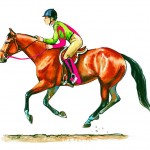Balance over your horse’s center of gravity in the two-point position.
By AQHA Professional Horseman Shane George with Christine Hamilton for The American Quarter Horse Journal

There are two basic seats for a hunter rider: full seat and half seat. For the hunters and jumpers, it’s important to have the ability to use both.
In a “full seat,” you have contact with your seat in the saddle. You sit on the horse’s back, riding each stride in a collected manner. It’s the seat you use in rail work.
In a “half seat,” you get up off your seat, out of the saddle and find a balance that’s a little more forward. It allows you to get your balance up and over your lower leg and over the horse’s center of gravity in his shoulder and wither. It’s a dynamic position, giving the rider more flexibility in how he moves with the horse.
How much your seat is out of the saddle depends on what you’re doing at the moment. If you’re in between jumps in a course, you might ride with your seat up but closer to the saddle, almost hovering over it. But if you’re going over a jump, your seat will be clearly up out of the saddle.
Trainers often use different term to describe variations in half seat. You often hear “two-point” used to mean a half seat or classic jumping position. However, two-point position and half-seat mean the same thing.
The lower leg is important for a good half seat because that’s your foundation as you hold your balance up over the horse’s balance.
In a hunter class, you want the horse to canter to a jump smoothly. A rider being a little off the horse’s back in a half seat absorbs a lot of the concussion and shock from the stride of the canter in the rider’s legs and heels. If you tried to sit and ride every stride in the saddle to the jump, that would create a lot of resistance.
What you look for in hunters is smoothness, good jumping style and an overall picture of making it look easy. The aerodynamic, balanced flexibility of a good half seat is the basis for achieving that.
Common Problems
Gripping with the knee:
A common problem in developing a good two-point in Quarter Horse riders is that they rely on pressure through their knee to find their balance, or they “pinch” with their knees. That’s their main contact point.
If the main contact and balance is through the knee, then you have a loose, swinging lower leg. You don’t have your leg against the horse’s side, so you’re not effective with your leg. You don’t have control, and it looks sloppy.
If you don’t have a secure lower leg, everything else won’t connect either. You’re rougher with your hands because you’ll use your hands to balance on the horse’s mouth, and that’s not the idea.
Your real foundation for balance and control is to have your lower leg against the horse’s side. Your support system should be below the knee. If you take your knee away from the saddle, automatically your strength and your balance will go lower into your leg. Your weight and balance will drop down into the lower calf, ankle and foot. That’s what holds you up.
Continue reading on America’s Horse Daily.
American Quarter Horse Association
1600 Quarter Horse Drive
Amarillo, TX 79104